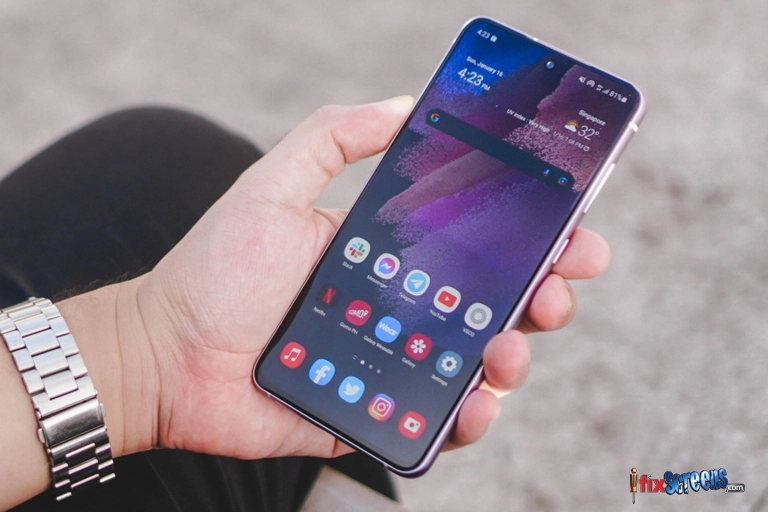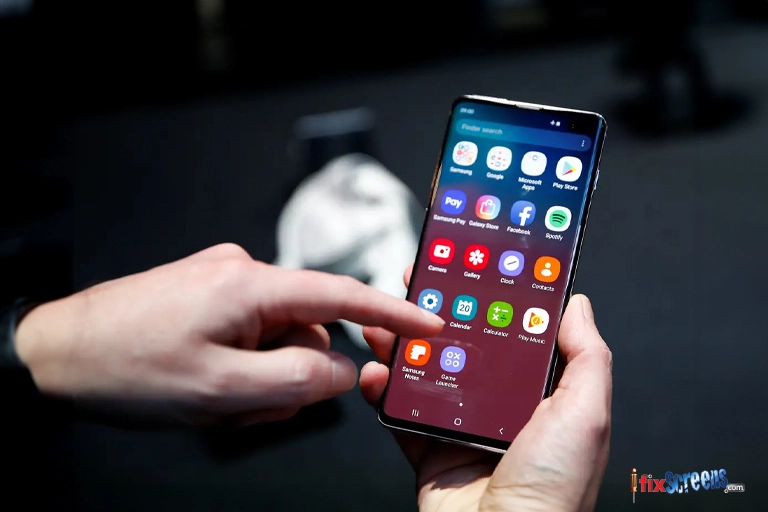Troubleshooting Guide: Samsung Galaxy Touch Screen Not Responding - Solutions and Fixes
It can be concerning when your Galaxy phone or tablet's touchscreen malfunctions. However, there are easy fixes to restore its functionality if it's frozen or unresponsive. Here at iFixScreens, we try to find simple solutions to your problems.
Here's a guide to diagnose the problem and get your touch back on track:

Key Takeaways
- Ensure your touchscreen's functionality by avoiding hindrances like damaged screen protectors, conductive objects, and wet conditions.
- Restart your Samsung Galaxy device to resolve minor issues with the touchscreen.
- Check for charger damage, as it may affect touchscreen functionality. Use a different charger if needed.
- Boot into Safe Mode to identify if a third-party app is causing touchscreen issues. Uninstall problematic apps.
- Regularly update your device's operating system to prevent touchscreen issues caused by outdated software.
- Disable gestures, adjust touch sensitivity, and deactivate TalkBack feature if necessary to improve touchscreen usability.
- Consider a factory reset as a last resort to resolve persistent touchscreen issues. Backup data before proceeding.
- If problems persist after trying solutions, seek professional repair services from authorized Samsung Galaxy repair centers like iFixScreens.
- Ensure a smooth smartphone experience by maintaining a responsive touchscreen. For further assistance, visit iFixScreens or contact Samsung customer service.
Basic Checks Are the Most Essential
Certain things can affect the touchscreen's functioning from the get-go point of view. Below are the list of things to be mindful of or avoid from the beginning:

Screen Protectors & Accessories:
Specific screen protectors or accessories might hinder touch responsiveness. Dust, air bubbles, or multiple layers under the protector can also cause issues. If your protector is peeling, consider replacing it.
Touch Input:
- Bare Fingers: Use your bare fingers for the best touch experience. Gloves, dust, fingernails, or other objects can affect touch sensitivity.
- Keep it Dry: Water can affect touch functionality. Even with waterproof models, some features might be limited in wet conditions.
Metal Objects:
Keep conductive objects like coins or keys away from the screen, as they can trigger unintended touch inputs.
S Pen Issues:
If you encounter problems with the S Pen, contact Samsung customer care or any repair shop specializing in S Pen repair.
Restarting the Device

Restarting the device can, most of the time, resolve minor issues. The method varies based on the model:
For devices with a Power key: Hold the Power key, then select Restart.
For devices with a Side button: Swipe down from the top, tap Power, then Restart.
If the touchscreen is unresponsive, press and hold the Volume down + Power/Side keys for 10 seconds to restart.
Inspect Your Charger for Damage.

A damaged charger might fail to power your device, leading to touchscreen issues. Use a different, undamaged charger to prevent malfunctions. Also, consider avoiding touchscreen use while the device is charging.
Going Into Safe Mode

Booting into Safe Mode temporarily turns off third-party apps. This helps identify if a downloaded app is causing the touchscreen issue. Here's how to enter Safe Mode:
Power off your phone completely.
Press and hold the Power button until the Samsung logo appears.
Press and hold the Volume Down button simultaneously when you see the logo.
Keep holding Volume Down until the phone finishes booting up. "Safe mode" is in the screen's bottom left corner.
In Safe Mode, test the touchscreen. If it works properly, the issue likely lies with a downloaded app. Uninstall any recently installed apps and restart your phone normally.
Regularly Check for Software Updates.

Samsung regularly updates its operating system to enhance software performance and address security concerns. Running an outdated OS might cause touchscreen issues. To update your Samsung Galaxy:
Navigate to Settings > Software update.
Select Check for software updates.
If your OS is up to date, you'll see a message confirming it. Or, follow the instructions to download and install the latest update.
Advanced Troubleshooting

Turn off Gestures
Full-screen gestures can hinder touch input as they're recognized as gestures. Disable them in Settings > Display > Navigation bar > Buttons.
Adjust Touch Sensitivity
If Touch sensitivity is too high without a protective film, it may cause touchscreen issues. To adjust, go to Settings > Display and toggle off Touch sensitivity.
Deactivate the TalkBack on Samsung Galaxy
Turn off the TalkBack feature on your Samsung Galaxy to improve touchscreen usability. While helpful for some, this feature can be confusing if you are not familiar with its gestures.
To turn it off, to Settings > Accessibility > TalkBack and toggle the switch.
Factory Reset (Last Resort)
If none of the above solutions work, consider a factory reset to restore your phone's data and settings to factory defaults. This should be a last resort as it erases all your data.
Warning: Back up your data thoroughly before proceeding with a factory reset.
If the problem persists after trying these solutions, your phone might have a hardware issue requiring professional repair. Contact Samsung customer service or visit a repair center like iFixScreens to get things sorted as soon as possible.
Final Thoughts
A well-functioning touchscreen is essential for a smooth smartphone experience. Following these simple tips, you can keep your Samsung Galaxy's touchscreen responsive and ensure you get the most out of your device.
If you have any further questions or encounter persistent issues, don't hesitate to visit the Samsung Galaxy repair in Staten Island for any assistance.
FAQ's
Q. What should I do if my Samsung Galaxy touchscreen is not responding?
A. If your Samsung Galaxy touchscreen is not responding, there are several steps you can take to resolve the issue. First, make sure your Galaxy device is charged and turned on. If it is, try restarting your phone to see if that resolves the problem.
Q. How do I know if my Samsung Galaxy touchscreen is malfunctioning?
A. If your Galaxy phone's touch screen is not working correctly, you may notice that it does not respond to your touch or that the sensitivity is off. In this case, you can check your device's settings to ensure the touchscreen feature is enabled.
Q. Can a screen protector prevent my Samsung Galaxy touchscreen from responding?
A. a screen protector on your Samsung Galaxy device may prevent the touch screen from responding correctly. Try removing the screen protector and see if that resolves the issue.
Q. What are some standard solutions to fix a non-responsive Samsung Galaxy touchscreen?
A. If your Samsung Galaxy touchscreen is not responding, you can try a few things to fix the issue. Restart your device, check for software updates, and ensure no apps or settings interfere with the touch function.
Q. Should I contact a Samsung authorized repair store if my touch screen is not responding?
A. If you have tried all the fixes and your Samsung Galaxy touchscreen is still not responding, contact a Samsung-authorized repair store.